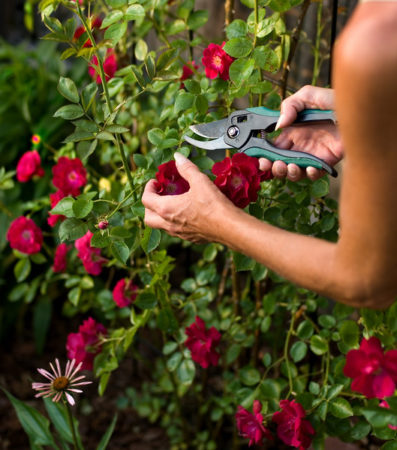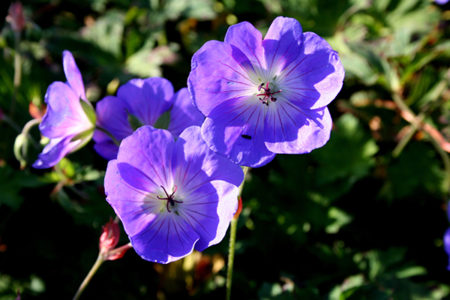|
||||
|
|
||||
 Flowering plants are all about their blooms. But they may need a little help. That’s because plants absorb nutrients from the soil, which then combine with sunlight to make food through photosynthesis. If any essential nutrients are missing from the soil, the plants may not produce the colorful, fragrant flowers you want. Those nutrients can be replenished, though, by fertilizing the soil, and the results will be the beautiful garden you envisioned. Fertilizer contains three macronutrients and a variety of micronutrients. The macronutrients are nitrogen, phosphorous and potassium, or N-P-K, and the percentage of each is printed on the package label. (K refers to the Latin name for potassium.) The percentage of each element appears on the label as three numbers, such as 10-20-10, which mean the fertilizer in the bag contains 10 percent nitrogen, 20 percent phosphorous and 10 percent potassium. Eight micronutrients are also needed for healthy plants, but in much smaller quantities. Micronutrients are boron (B), chlorine (Cl), copper (Cu), iron (Fe), manganese (Mn), molybdenum (Mn), nickel (Ni) and zinc (Zn). Each plant needs a different mixture of these elements, which means there is no one size fits all fertilizer. Even the macronutrients need to be varied for different purposes. To encourage flowers, fertilizer needs a predominance of phosphorous (middle number). Lawn fertilizer, on the other hand, needs more nitrogen, which promotes leaf growth, and less phosphorous and potassium. If you are fertilizing acid loving plants like azaleas or rhododendrons, the fertilizer probably needs to include sulfur-based acid. That’s because most soil in our area ranges from neutral to basic or alkaline. There’s a lot to soil science, and we have the people on staff who have studied the subject thoroughly. If you’ve planted flowers and they look like they could use some help, we’ll be happy to analyze your soil and then formulate and apply just the right fertilizer so you’ll have flowers you can be proud of. |
||||
|
|
||||
 Most roses should be pruned in spring. Many growers peg the appearance of forsythia blooms as the start of the rose pruning season, and forsythia has bloomed here in our area.There are many different types of roses, and each has different pruning techniques. Roses are among the most hybridized plant, but roses that are closer to the species require less severe pruning than those that are highly hybridized. Hybrid tea roses are at the other extreme. Like all plants, you should have an objective in mind when you head to the rose garden with pruning shears in your gloved hand. Most roses should be pruned in spring. Many growers peg the appearance of forsythia blooms as the start of the rose pruning season, and forsythia has bloomed here in our area.There are many different types of roses, and each has different pruning techniques. Roses are among the most hybridized plant, but roses that are closer to the species require less severe pruning than those that are highly hybridized. Hybrid tea roses are at the other extreme. Like all plants, you should have an objective in mind when you head to the rose garden with pruning shears in your gloved hand.
The most common pruning objective is to remove dead, damaged, or diseased wood. If the plant is thick and tangled, your objective could be to relieve the tangle and increase air circulation. Shaping the plant and encouraging the growth of flowering wood are also valid objectives. Regardless of your objectives, the type of roses you plan to prune and the severity of your pruning, here are some general recommendations:
Everybody loves beautiful roses but some gardeners shy away from them because they don’t like the thorns, or because they don’t want to research specific pruning techniques for their varieties, or they are nervous about doing it wrong. We don’t want any of those reasons to deter you from enjoying a rose garden. All you have to do is call us and our skilled technicians will prune your roses perfectly. You can then sit back and enjoy your roses’ fragrance and beauty. |
||||
| Feature Plant Of The Month – Rozanne Geranium |
||||
 Geranium Rozanne® is an award-winning, hardy, perennial geranium. (The popular annual geraniums are in the genus Pelargonium.). As a perennial, the Rozanne geranium will die back every fall and re-emerge each spring. You’ll be delighted with the prolific blue-violet and white flowers that cover the plant from May through the first autumn frost. In return for this full season of color, all the Rozanne geranium asks for is good drainage. It just doesn’t like wet feet, but it isn’t fussy about whether it’s planted in sun or shade. One caution – give it plenty of space because this plant spreads. It doesn’t sprawl, but it does spread. You really get your money’s worth! Geranium Rozanne® is an award-winning, hardy, perennial geranium. (The popular annual geraniums are in the genus Pelargonium.). As a perennial, the Rozanne geranium will die back every fall and re-emerge each spring. You’ll be delighted with the prolific blue-violet and white flowers that cover the plant from May through the first autumn frost. In return for this full season of color, all the Rozanne geranium asks for is good drainage. It just doesn’t like wet feet, but it isn’t fussy about whether it’s planted in sun or shade. One caution – give it plenty of space because this plant spreads. It doesn’t sprawl, but it does spread. You really get your money’s worth!
Countrycare Landscape Management |